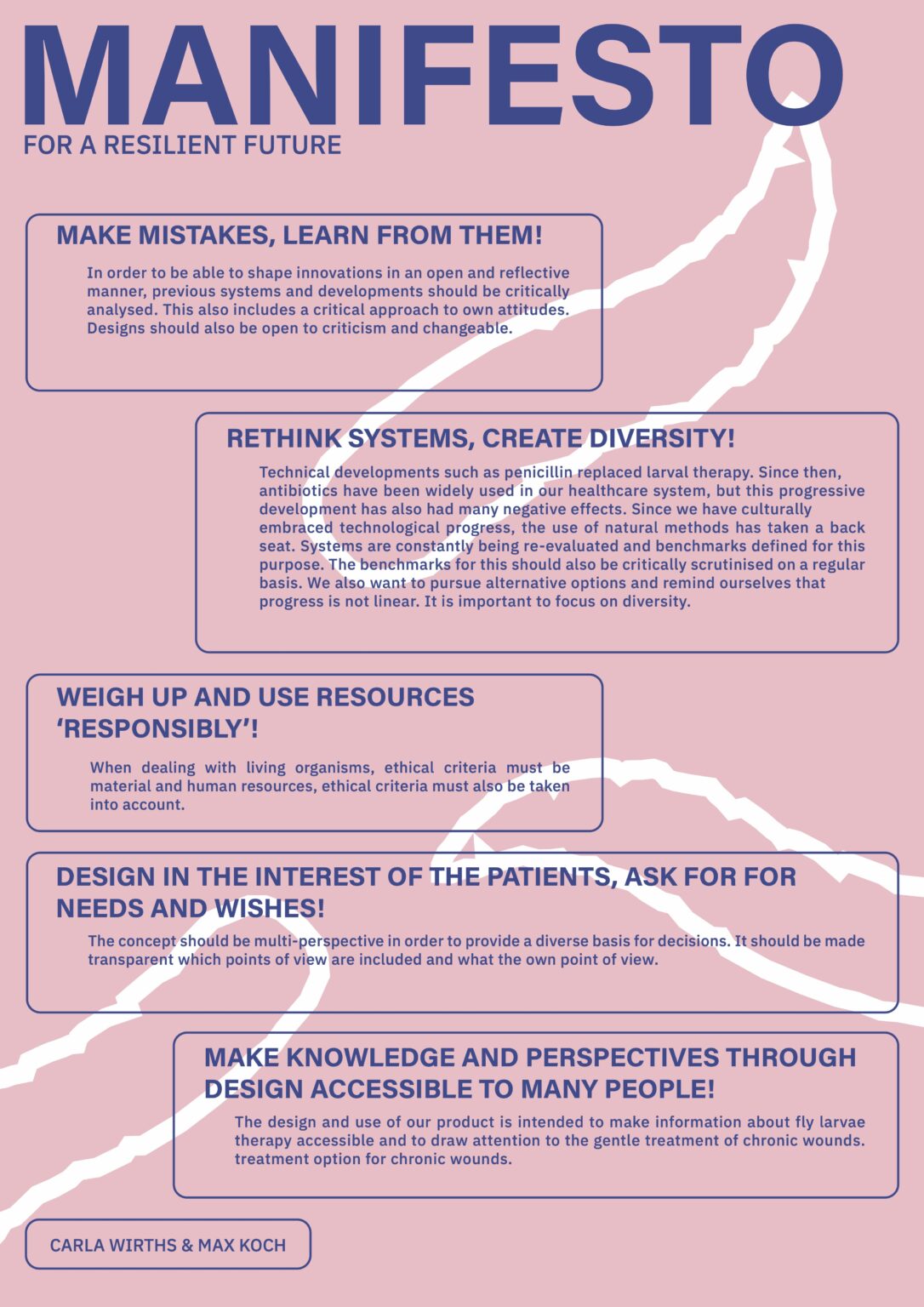SipBag
the living wound cover
SipBag is a living wound dressing for chronic wounds. Gold fly larvae enzymatically remove dead tissue, digest resistant bacteria and excrete antibiotic substances. Thanks to the flexible adaptation to various wounds, the non-slip fixation and the pressure protection, the therapeutic success is safer and more accessible. The involvement of the natural process saves resources and offers a gentle alternative to surgery. The production of the SipBag takes place in local companies using standard tools, with minimum waste and at low cost. Gold flies can be responsibly taken from nature almost anywhere in the world. The compact rearing, sterilisation, ad hoc filling and sealing of the SipBag takes place in the hospital pharmacy.
| student: | Carla Wirths & Max Koch |
| project: | The Insect Project – Resilience Part I |
| year: | 2023/24 |
Around 3 million people in Germany suffer from chronic wounds. By definition, these are wounds that have not healed after 8 weeks. There are various causes. 80 % of these wounds, especially on the legs, are caused by vascular disease or nerve damage. Diabetics and the elderly are particularly affected by chronic wounds. The wound treatment of chronic wounds takes place in hospital and usually consists of treating the cause and surgically removing dead tissue to create better conditions for wound healing. This usually requires several interventions.
Alternative treatment methods to technical interventions already exist. These include the maggot debridement therapy. The benefits of this method can be traced back historically and are already mentioned in the Bible. With the invention of penicillin, however, its use declined sharply. Due to increasing multi-resistance, fly larvae are being used again today. They are placed on the wound in gauze bags. However, this treatment method is not yet used as a standard method.
The SipBag is an optimized living wound dressing for chronic wounds. The golden fly larvae live in its well-sealed inner chamber. The air- and fluid-permeable material allows them to absorb substances from the wound and release substances into the wound. They enzymatically remove dead tissue, digest even multi-resistant bacteria and excrete antibiotic substances. This stimulates healing and wound granulation. The bag can be flexibly adapted to various wounds and body parts. The non-slip fixation makes the therapy safer and more barrier-free. The pressure protection helps patients to move around with the wound dressing without worrying about crushing the larvae. This means that the wound dressing can also be increasingly used for patients who tend to press on the wound dressing due to their dementia, for example. The strong inclusion of the natural biological process saves resources and costs and reduces the use of invasive measures on the patient. The SipBag optimizes and normalizes maggot therapy. It further emphasizes the relevance of the topic of chronic wounds.
The SipBag shall be produced by local companies using standard tools, with low waste and at low cost. Gold flies can be taken from nature almost anywhere in the world. It is important to take the resource in doses and to observe the local population. Gold flies can then be replicated quickly in rearing. This can take place in independent rearing stations, but also on site in the hospital pharmacy, as it is possible to provide compact rearing stations without great effort. During rearing, the reared flies should be regularly mixed with wild ones to keep their natural effectiveness high and avoid inbreeding. Before the larvae are filled, they are made sterile. After filling in the SipBag, the open filling area is sealed.
The SipBags can be attached to various parts and curves of the body using the strips provided on the edge of the bag. If these are not required, they can be cut off by the nursing staff with scissors along the cut contour. Several SipBags can also be attached close together to cover large wounds. A bandage is then applied to the SipBag. In this way, the larvae are not in the permanent field of vision of the patient, who may be disgusted by the animals. The SipBag should be left on the wound for up to 5 days so that as many of its antibiotic secretions as possible can be used.
After this time, the SipBags are thermally recycled due to the risk of contamination.

